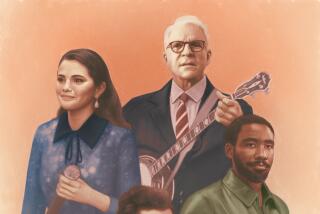Supporting actors are TV’s secret weapon. Let us count the ways
Eighteen minutes into the first episode of Hulu’s “High Fidelity,” something big happens. Until now, we’ve been learning about Rob (Zoë Kravitz), the series’ central character, and her romantic past, at mid-tempo and moderate volume.
Enter Cherise, played by Da’Vine Joy Randolph, one of two employees at the record store Rob owns, a substantial vision in stripes. “What up, babies?” (pronounced “babeeeez”), she says, then profanely attacks the music that co-clerk Simon (David H. Holmes) is playing, takes it off, puts on Dexys Midnight Runners’ “Come On, Eileen” and dances energetically in the aisles.
Like Jack Black’s Barry, the character in the “High Fidelity” film whom Cherise reboots, she is large and loud and frighteningly passionate. While Rob, leading a semi-comic depressive tour through her failed love life, is the questing character in whom we’re meant to recognize our own missteps and longings, Cherise is an inspirational figure. She knows things, she commands space, she has dreams and eventually a plan — to become an artist herself. And we wonder, about Randolph as much as about Cherise, “Who is this person?”
We are trained or perhaps hard-wired to look for the hero and the villain in a story, to invest in their outcomes, even when the person holding the hero’s coat may be more interesting. We are inclined to prize the quarterback above the tight end, the pitcher over the shortstop, the soloist over the accompanist, the lead rather than the background singer; indeed, we make assumptions about their talent, though the stars may be no more skilled (or even less skilled) than actors further down the bill who will be called upon to pick up their slack.
Supporting actors, who are sometimes but not always “character actors,” make up the ranks of best friends, colorful sidekicks, strange relations, eccentric co-workers, superior officers, crazy neighbors and service workers. In life, stars are the outliers, “bigger than life.” Life is what supporting actors bring, a taste of the world as most of us routinely experience it; they provide color, context, depth. They create a community, where the stars stand alone. Stars are other people. Supporting actors are us.
In old Hollywood, studios kept ranks of these players on contract, as a kind of human spice rack from which to season a film — a pinch of Franklin Pangborn here, a dash of Elsa Lanchester there. Directors, too, created stock companies of character actors whose familiar presence made a film seem automatically friendly: John Ford with Ward Bond and Mary Gordon, among many others; Preston Sturges and his go-to gruff guy, William Demarest (later a supporting actor Emmy winner for playing Uncle Charlie on TV’s “My Three Sons”). Wes Anderson notably does something of the same nowadays: As much as anything, his films offer a chance to catch up with Jason Schwartzman.
As the characters in whose triumph or tragedy we are mainly invested, the leads in a story can be chained to the narrative, weighed down with the burden of their role. Secondary characters, bearing less responsibility, are free to be their eccentric or, for that matter, ordinary selves. They are attractively free, and I can’t be the only viewer of film and television to be more drawn to the sidekick, the sibling, the facilitator than to the supposed center of the action.
What is “Hamlet” without Ophelia, Gertrude, Laertes, even Rosencrantz and Guildenstern — characters with relatively little to say but important business to discharge, and whose very presence warms the cold walls of Elsinore? What is “Star Wars” without the comical robots, the little lizard wizard, the big fuzzball? “The Mary Tyler Moore Show” without Lou, Rhoda, Ted, Phyllis, Murray and Sue Ann — which is to say, minus Ed Asner, Valerie Harper, Ted Knight, Cloris Leachman, Gavin MacLeod and Betty White?
Television, with tracts of time to fill, is friendly to large casts and secondary story lines, as well as to ensemble pieces in which every actor is supporting and also a star. The distinctions can be fuzzy anyway. Big stars sometimes take small roles, and character actors will sometimes be cast in the lead e.g., J.K. Simmons in “Counterpart”). Alan Arkin was Emmy-nominated as a supporting actor for “The Kominsky Method,” a series in which he might reasonably be described as co-starring. Maisie Williams was nominated as supporting actress in a drama for “Game of Thrones,” even though, as Arya Stark, she killed the Night King.
Alex Borstein as Susie Myerson is more interesting to me than anything Rachel Brosnahan has to do as title character of “The Marvelous Mrs. Maisel.” “Mad Men” to my mind is not Jon Hamm, but Jared Harris, Christina Hendricks, John Slattery, Elisabeth Moss, Robert Morse and innumerable others who came and went across the series’ seven seasons.
On “The Sopranos,” everyone who isn’t James Gandolfini was a supporting actor, and while there was no “Sopranos” without Gandolfini, and every other character was expendable, it would have been a different show without Nancy Marchand and Dominic Chianese and Steven Van Zandt. “Lost” was heavily invested in the fates of its prettiest people, but Jorge Garcia as Hurley and Terry O’Quinn as Locke were its soul. (O’Quinn is something of a superstar among supporting players, with regular or recurring roles in “Emergence,” “Perpetual Grace, LTD,” “Hawaii Five-0,” “Patriot” and “Castle Rock” just since 2018).
I’ll watch anything featuring Loretta Devine — most recently on “Family Reunion,” though my affection runs back two decades to “The PJs,” in which she was only a voice. Luis Guzman (“Godfather of Harlem,” “How to Make It in America”) is a sign of a production smart enough to cast him. Donal Logue (“Gotham,” “Stumptown”) always gets my attention; the presence of Henry Winkler has come to signal smart, weird comedy. (His work in “Barry” earned him an Emmy in 2018.) Rita Moreno, who would have been a leading lady had she been young in a less bigoted time, elevated “Oz” in the last century and adds spark to “One Day at a Time” in this one. Parker Posey, who has a memorable guest role in “High Fidelity,” has gracefully walked a line between lead and support for years. (She’s now playing Dr. Smith in the rebooted “Lost in Space” — I guess you’d have to call that a starring role.) This is only a partial list. You likely have your own.
A universe composed only of stars would be a dull one. Once, a long time ago, I saw a band called Blue Oyster Cult in concert, and at one point every musician was standing at the front of the stage playing an identical figure on the electric guitar. It was impressive, in a hilarious sort of way, but after a minute you wanted to hear drums again.
In the final episode of “High Fidelity’s” first season, we are faced, again, with the questions of whether Rob will get back together with an old boyfriend, or get together with someone new, or whatever. Kravitz is very good in these inevitable emotional showdowns. Yet the scene that actually moves me belonged to Randolph, as Cherise, who wants to start a band, considered a guitar she had unexpectedly received as a gift. Standing her entrance in the series on its head, she turns quiet, at once showing and masking an array of feelings. Something’s coming, you feel, something good.
More to Read
The complete guide to home viewing
Get Screen Gab for everything about the TV shows and streaming movies everyone’s talking about.
You may occasionally receive promotional content from the Los Angeles Times.







